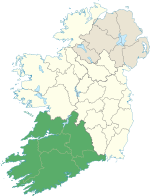Cnoc na Toinne
| Cnoc na Toinne | |
|---|---|
 Devil's Ladder col as seen from Carrauntoohil, with the summit ridge to Cnoc na Toinne behind | |
| Highest point | |
| Elevation | 845 m (2,772 ft)[1] |
| Prominence | 80 m (260 ft)[1] |
| Listing | Hewitt, Arderin, Simm, Vandeleur-Lynam |
| Coordinates | 51°59′26″N 9°43′53″W / 51.990437°N 9.731475°W[1] |
| Geography | |
| Location | County Kerry, Ireland |
| Parent range | MacGillycuddy's Reeks |
| OSI/OSNI grid | V811834 |
| Topo map | OSI Discovery 78 |
| Geology | |
| Mountain type(s) | Well-bedded grey sandstone, (Lough Acoose Sandstone Formation)[1] |
| Climbing | |
| Easiest route | Devil's Ladder (via Hag's Glen) |
Cnoc na Toinne (Irish for "hill of the wave"),[a][2] at 845 metres (2,772 ft), is the 17th-highest peak in Ireland on the Arderin list, and the 23rd-highest peak in Ireland on the Vandeleur-Lynam list. It is part of the MacGillycuddy's Reeks range in County Kerry. Cnoc na Toinne lies between the Coomloughra Reeks and the Eastern Reeks, and is just above the col of the Devil's Ladder, a popular route for climbing Carrauntoohil, Ireland's highest mountain.
Geography
[edit]
Cnoc na Toinne is most frequently encountered as the minor summit that forms the col with Carrauntoohil, through which most hill walkers travel on their way summiting Ireland's highest mountain. The col is most commonly accessed from the Hag's Glen (via Cronin's Yard), by ascending a loose rocky path known as the Devil's Ladder (see photo opposite).[b][4][5]
Because of the deterioration of the Devil's Ladder path, hill walkers also use the Zig-Zag path on the northern side of the north-west spur of Cnoc na Toinne, known as Bóthar na Gíge, as an alternative route. This path brings walkers closer to the actual summit of Cnoc na Toinne.[6][7]
Cnoc na Toinne lies between the Coomloughra Reeks and the Eastern Reeks and effectively separates the two main sections of the MacGillycuddy Reeks range, each section containing half of the Reeks summits that are above 3,000 ft in height. The north-easterly ridge that rises up from the top of the Devil's Ladder col to Cnoc na Toinne, then rises further to neighbouring Cnoc an Chuillinn 958 metres (3,143 ft), where is runs in a straight north-easterly direction, taking in several major summits, connected by a high sharp ridge, before ending at Cruach Mhór 932 metres (3,058 ft).[7][4]

Cnoc na Toinne is the 798th-highest mountain in Britain and Ireland on the Simm classification.[8] Cnoc na Toinne's prominence qualifies it to meet the Arderin classification, and the British Isles Simm and Hewitt classifications.[8] Cnoc na Toinne does not appear in the MountainViews Online Database, 100 Highest Irish Mountains, as the prominence threshold is over 100 m (328 ft).[9]
Notes
[edit]- ^ Paul Tempan in Irish Hills and Mountain Names notes that it has also been called Irish: An Caisleán Gael, meaning 'the bright castle'.[2]
- ^ It is not clear whether the term Devil's Ladder is linked to the Irish proverb: "Go ndeine an diabhal dréimire de cnámh do dhroma ag piocadh úll i ngairdín Ifrinn." (May the devil make a ladder of your backbone [and] pluck apples in the garden of hell).[3]
References
[edit]- ^ a b c d MountainViews: Cnoc na Toinne
- ^ a b Tempan, Paul (February 2012). "Irish Hill and Mountain Names" (PDF). MountainViews.ie.
- ^ "May the devil make a ladder of your backbone [and] pluck apples in the garden of hell". Daltaí na Gaeilge. Retrieved 12 December 2018.
Go ndeine an diabhal dréimire de cnámh do dhroma ag piocadh úll i ngairdín Ifrinn / May the devil make a ladder of your backbone [and] pluck apples in the garden of hell.
- ^ a b Dillion, Paddy (1993). The Mountains of Ireland: A Guide to Walking the Summits. Cicerone. ISBN 978-1852841102.
- ^ Dillon, Paddy (1998). Exploring the South of Ireland. Ward Lock. ISBN 0-7063-7566-1.
- ^ Siggins, Lorna (24 February 2018). "Chaos on Carrauntoohil: Too few guides, too late starting". Irish Times.
The party reached the summit at about 3pm, and the plan was to descend via the "Zig Zags", an old mule path down the north side of Cnoc na Toinne. This descent is regarded as safer, although serious accidents have occurred on that part of the route before. However, some of the walkers opted for the Devil's Ladder.
- ^ a b Ryan, Jim (2006). Carrauntoohil and MacGillycuddy's Reeks: A Walking Guide to Ireland's Highest Mountains. Collins Press. ISBN 978-1905172337.
- ^ a b Cocker, Chris; Jackson, Graham (2018). "The Database of British and Irish Hills". Database of British and Irish Hills.
- ^ Mountainviews, (September 2013), "A Guide to Ireland's Mountain Summits: The Vandeleur-Lynams & the Arderins", Collins Books, Cork, ISBN 978-1-84889-164-7
See also
[edit]- Lists of mountains in Ireland
- List of mountains of the British Isles by height
- List of Furth mountains in the British Isles
External links
[edit]- MountainViews: The Irish Mountain Website, Cnoc na Toinne
- MountainViews: Irish Online Mountain Database
- The Database of British and Irish Hills , the largest database of British Isles mountains ("DoBIH")
- Hill Bagging UK & Ireland, the searchable interface for the DoBIH
- Ordnance Survey Ireland ("OSI") Online Map Viewer
- Logainm: Placenames Database of Ireland



